 Journal of Modern Physics, 2013, 4, 56-63 http://dx.doi.org/10.4236/jmp.2013.41010 Published Online January 2013 (http://www.scirp.org/journal/jmp) On One Possibility of Closuring the Chain of Equations for Statistical Moments in Turbulence Theory Edward V. Teodorovich The Institute for Problems in Mechanics, Russian Academy of Sciences, Moscow, Russia Email: teodor@ipmnet.ru Received September 25, 2012; revised October 28, 2012; accepted November 7, 2012 ABSTRACT The paper concerns the problem on statistical description of the turbulent velocity pulsations by using the method of characteristic functional. The equations for velocity covariance and Green’s function, which describes an average ve- locity response to external force action, have been obtained. For the nonlinear term in the equation for velocity covari- ance, it has been obtained an exact representation in the form of two terms, which can be treated as describing a mo- mentum transport due to turbulent viscosity and action of effective random forces (within the framework of traditional phenomenological description, the turbulent viscosity is only accounted for). Using a low perturbation theory approxi- mation for high statistical moments, a scheme of closuring the chain of equations for statistical moments is proposed. As the result, we come to a closed set of equations for velocity covariance and Green’s function, the solution to which corresponds to summing up a certain infinite subsequence of total perturbation series. Keywords: Random Velocity Field; Statistical Description; Characteristic Functional; Chain of Equations for Moments; Problem of Closuring 1. Introduction The problem on statistical description of turbulence, even at the simplest assumptions of stationary state and ho- mogeneity of the velocity field, so far remaines to be unsolved in spite of its scientific and practical impor- tance. The point at hand is a search for statistical solution of the Navier-Stokes equation with the availability of external random force (the Langevene force), which si- mulates the generation of turbulent energy due to the development of instability of large-scale flows at high Reynolds numbers. Statistical description of turbulent flows means a knowledge of probability to find a given realization of the velocity field in the elementary volume of the space of velocity field realizations that are solutions to hydrodynamic equations (the Na- vier-Stokes equations) [1,2]. The relevant probabilistic measure may be written as ,tur d ,dtur ,tdt ur ,Pt ur ,,1dt ur ,t ur ,,dtP ur ur (1.1) where is the functional probability density being subject to the normalization condition Pt ur (1.2) where the integration is carried out over all possible ve- locity field realizations. An experimental determination of the probability density of the velocity field realization is a challenging (in fact impractable) task. A knowledge of the probability density is equivalent to one of velocity field statistical moments (of all orders). An experimental determination of statistical moments (of finite order) seems to be more actual for approximate describing the field of turbulent velocity pulsations. How- ever, the attemps to obtain equations for statistical moments appear to be unsuccessful since, due to the nonlinearity of Navier-Stokes equations, the equation for statistical moment of given order includes statistical moments of more high orders, and thus an infinite chain of coupled equations arises. It is the chain by Keller and Friedman [3], which is similar to the well-known in statistical physics chain by Bogoly- ubov-Born-Green-Ivon-Kirkwood [4]. Thus, the problem of cutting off this chain (closure problem) arises. There exist a large body approaches to solving this problem, among which the most simple is neglecting the terms containing moments of order higher then some chosen. Another possibility reduces to attempt to express high-order moments in terms of low-order ones, for example, using the congecture of quasinormal- ity or log-normality, however, this often leads to non- physical results of a type of negative probability [5]. Another widely used possibility of solving the closure problem reduces to a certain phenomenological hypothe- sis on connection between high-order and low-order C opyright © 2013 SciRes. JMP  E. V. TEODOROVICH 57 moments of the type the hypotheses of turbulent viscos- ity or of mixing length. As the result, it occurs to be pos- sible to achieve a satisfactory agreement with experi- mental data in a limited domain of wavenumbers and frequencies. The method of “direct interaction approximation” pro- posed by R. Kraichnan [6] (see also [7]) can be treated as a further development of the moment method. Within the framework of this method, in addition to statististical moments, Kraichnan introduces into consideration a function of averaged response of velocity field to exter- nal force action (Green’s function), which is defined as a solution of the problem on diffusion transfer in a random velocity field at given statistics of the velocity field. It should be also mentioned the method of constructing a statistical solution to the Navier-Stokes equations using the perturbation theory when the nonlinear term in Na- vier-Stokes equation is considered as perturbation, and, while culculating statistical moments, a solution for ve- locity is presented in the form of series in the parameter of nonlinear interaction with subsequent multiplication of series obtained and term-by-term averaging the resulting expression (“simple perturbation theory”). However, in fact the nonlinear term is not small, the dimensionless parameter of nonlinear interaction is defined by Reynolds number, which is very large in the case of fully devel- oped turbulence. Due to this fact, the convergence of perturbation series is slow, i.e. a knowledge of several first terms in perturbation series appears to be not suffi- cient for estimating the behaviour of turbulent character- istics being a subject of interest. The problem turns out to be similar to that of strong interactions in quantum field theory, where the methods of improving perturbation theory with the help of partial summing up an infinite subsequence of total perturbation series by solving Dy- sons’ equations were developed (“improved perturbation theory”). As applied to description of turbulence, a rele- vant approach has been proposed by H. Wyld [8]. In his analysis of pertubation series, he used Feynmann’s dia- gram techniques from quantum field theory, where to every term of perturbation series there are assigned some graphic symbols with prescribed pictorial physical meaning as processes of quanta production, annihilation or propagation. Note that the effective Reynolds number defined as a ratio of energy input to given mode from large-scale modes to the value of viscous absorbtion caused by interaction with smale-scale modes appears to be approximately unit under the conditions of stationary developed turbulence. This provides more rapid conver- gence of perturbation series. Also note that, within the framework of “improved perturbation theory”, the per- tubation method is used for finding some quantities con- nected with a solution (for example, the self-energy op- erator in quantum field theory). A substitution of this quantity into the equation and sequent solving that cor- responds to summing up a certain infinite subsequence of total perturbation series. It should be also pointed out an alternative possibility to improve the perturbation theory related to application of the renormalization-group (RG) method (see reviews [9,10]), this approach corresponds to summing up a cer- tain (but yet another) infinite subsequence of total series. One more peculiarity of developed turbulence, which enables one to reveal the key features of the energy spec- trum of turbulent velocity pulsations in some wave- number range, is a conjecture that the turbulent spectrum is formatted due to nonlinear interactions between modes of close scales, whereas interactions between modes with significantly different scales are performed through the cascade sequence of interactions between modes of all intermediate scales (Richardson’s cascade), in other words, one has to tell about “a locality of intermode in- teractions in the wave-number space” [11]. This is ex- plained by the fact that the interaction between modes of significantly different scales reduces to a simple me- chanical translation of small-scale modes by large-scale ones without energy redistribution [12]. This brings up the problem of separating strong interactions between modes with essentially different scales, which reduce to translation, from weak interactions between modes of close scales that execute the energy transfer along the wave-number spectrum [13]. The concept of locality of intermode couplings lies at the basis of describing turbulence within the framework of renormalization-group method [14], and, in particular, the method of -expansion, which makes an integral part of the RG-technique, should be treated as a way of separating off local interactions from nonlocal interations, which do not take part in formatting the spectrum [14]. The hypothesis of locality enables one to predict the shape of energy spectrum in a certain wave-number range (Kolmogorov’s spectrum), which turns out to be in good agreement with experimental data. The present investigation aims to obtain a closed set of equations for two functions of direct interest, namely, the covariance of velocity field and the function of averaged responce to external force action (Green’s function). Similarly to the formulation of turbulence theory in terms of statistical moments, in the approach proposed, a chain of equations for quantities through which statisticl mo- ments of velocity field can be expressed arises. A closure of this chain is performed by using the perturbation the- ory at a certain stage. This enables one to obtain a set of equations for two scalar functions. A solution to these equations corresponds a sum of some infinite subse- quence of the total pertubation-theory series. The method of space-time characteristical functional and the equation in functional derivatives for that are used in probabilistic Copyright © 2013 SciRes. JMP 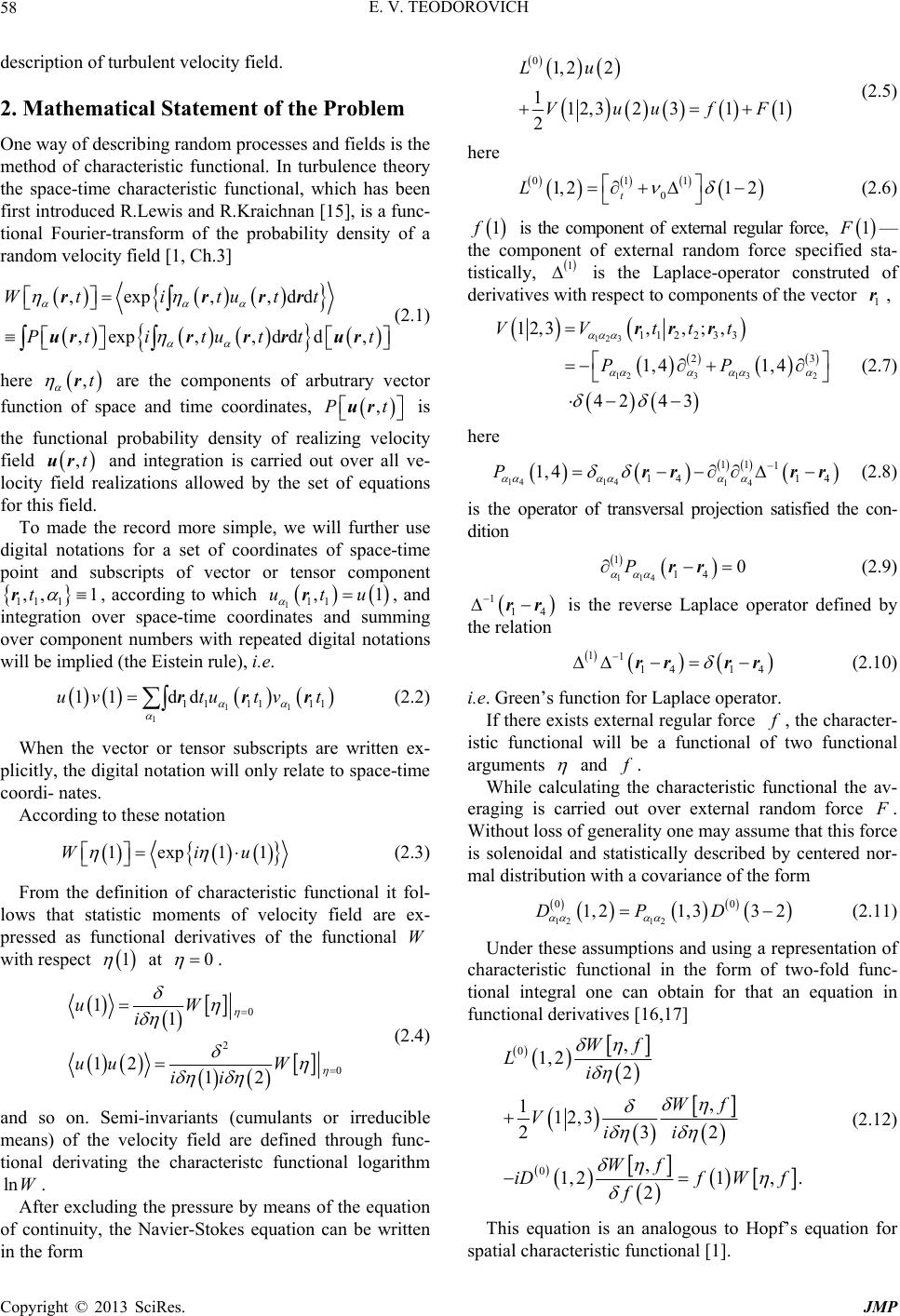 E. V. TEODOROVICH 58 description of turbulent velocity field. 2. Mathematical Statement of the Problem One way of describing random processes and fields is the method of characteristic functional. In turbulence theory the space-time characteristic functional, which has been first introduced R.Lewis and R.Kraichnan [15], is a func- tional Fourier-transform of the probability density of a random velocity field [1, Ch.3] ,exp, , ,exp, ,d Wt itu Pti tut rr urrr r dd dd , tt t t rr ur ,t r (2.1) here are the components of arbutrary vector function of space and time coordinates, ,Pt ur ,tur ,, 1t r is the functional probability density of realizing velocity field and integration is carried out over all ve- locity field realizations allowed by the set of equations for this field. To made the record more simple, we will further use digital notations for a set of coordinates of space-time point and subscripts of vector or tensor component 11 1, according to which ,1utur 111 , and integration over space-time coordinates and summing over component numbers with repeated digital notations will be implied (the Eistein rule), i.e. 11 11 11 tv t rrr 1 1 1 11 dduv tu (2.2) When the vector or tensor subscripts are written ex- plicitly, the digital notation will only relate to space-time coordi- nates. According to these notation 1exW p11iu 10 (2.3) From the definition of characteristic functional it fol- lows that statistic moments of velocity field are ex- pressed as functional derivatives of the functional W with respect at . 0 0 12 W 2 11 12 uW i uu ii lnW (2.4) and so on. Semi-invariants (cumulants or irreducible means) of the velocity field are defined through func- tional derivating the characteristc functional logarithm . After excluding the pressure by means of the equation of continuity, the Navier-Stokes equation can be written in the form 01, 22 112,3231 1 2 Lu VuufF 011 0 1, 212 t L (2.5) here (2.6) 1 is the component of external regular force, 1F 1 — the component of external random force specified sta- tistically, is the Laplace-operator construted of derivatives with respect to components of the vector , 1 r 123 12 313 2 11223 3 23 12,3,, ; , 1, 41, 4 42 43 VVttt PP rr r 14 1414 11 1 14 14 1, 4P rr rr 14 1 1 14 0P (2.7) here (2.8) is the operator of transversal projection satisfied the con- dition rr (2.9) 1 rr 11 14 14 rr rr 14 is the reverse Laplace operator defined by the relation (2.10) i.e. Green’s function for Laplace operator. If there exists external regular force , the character- istic functional will be a functional of two functional arguments . and While calculating the characteristic functional the av- eraging is carried out over external random force . Without loss of generality one may assume that this force is solenoidal and statistically described by centered nor- mal distribution with a covariance of the form 12 12 00 1, 21,332DPD (2.11) Under these assumptions and using a representation of characteristic functional in the form of two-fold func- tional integral one can obtain for that an equation in functional derivatives [16,17] 0 0 , 1, 22 , 112,3 232 , 1,21, . 2 Wf Li Wf Vii Wf iDf Wf f (2.12) This equation is an analogous to Hopf’s equation for spatial characteristic functional [1]. Copyright © 2013 SciRes. JMP 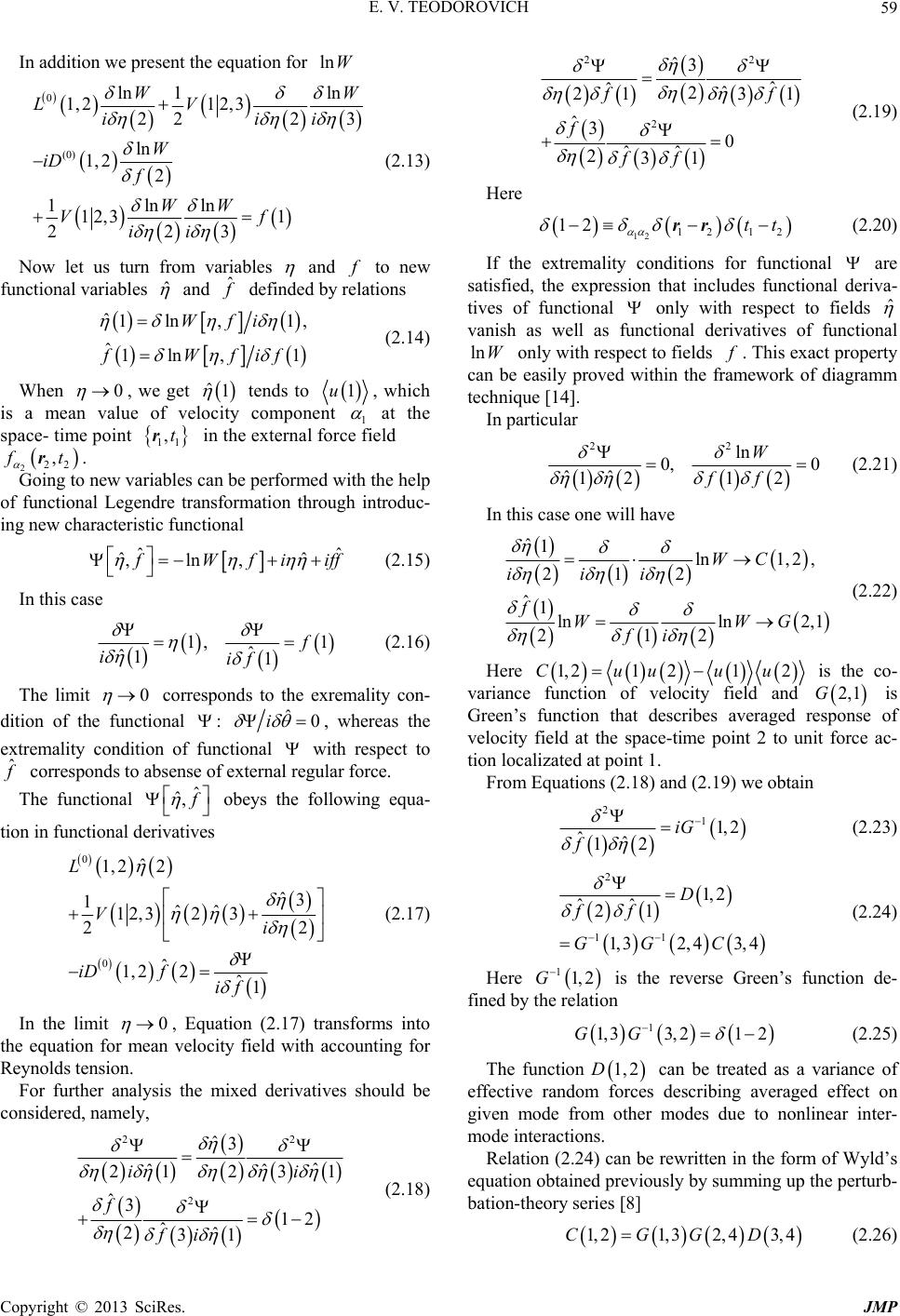 E. V. TEODOROVICH 59 In addition we present the equation for lnW ln 2 3 1 3 WW i 0 (0) ln 1 1, 212,3 22 ln 1, 22 1lnln 12,3 22 LV ii W iD f WW Vf ii (2.13) Now let us turn from variables and to new functional variables ˆ and ˆ definded by relations ˆ1ln ˆ1ln , 1, , 1 Wfi Wfif (2.14) When 0 , we get tends to ˆ1 1u, which is a mean value of velocity component 1 at the space- time point in the external force field . 11 ,tr ˆˆ ˆˆ ,f iiff ,ftr 222 Going to new variables can be performed with the help of functional Legendre transformation through introduc- ing new characteristic functional ,l nf W (2.15) In this case 1 ˆ1 1, ˆ1 i if 0 (2.16) The limit corresponds to the exremality con- dition of the functional : ˆ0 i ˆ , whereas the extremality condition of functional with respect to corresponds to absense of external regular force. The functional ˆ ˆ, obeys the following equa- tion in functional derivatives 0 0 ˆ 1, 22 1ˆˆ 12,3 2 ˆ 1, 22 L V iD f ˆ3 3 22 ˆ1 i if 0 (2.17) In the limit , Equation (2.17) transforms into the equation for mean velocity field with accounting for Reynolds tension. For further analysis the mixed derivatives should be considered, namely, 22 ˆˆ ˆ 231 12 ii 2 ˆ3 2 1 ˆ3 ˆ 2ˆ 31 f fi (2.18) 22 2 ˆ3 ˆˆ 2ˆ 21 31 ˆ30 ˆˆ 231 ff f ff (2.19) Here 12 12 12 12 tt rr (2.20) If the extremality conditions for functional are satisfied, the expression that includes functional deriva- tives of functional ˆ only with respect to fields vanish as well as functional derivatives of functional only with respect to fields lnW . This exact property can be easily proved within the framework of diagramm technique [14]. In particular 22 ln 0, 0 ˆˆ 121 2 W ff (2.21) In this case one will have ˆ1ln1, 2, 212 ˆ1lnln 2,1 212 WC iii fWWG fi (2.22) 1, 21212Cuuuu Here is the co- variance function of velocity field and 2, 1G is Green’s function that describes averaged response of velocity field at the space-time point 2 to unit force ac- tion localizated at point 1. From Equations (2.18) and (2.19) we obtain 2 11, 2 ˆˆ 12 iG f (2.23) 2 11 1, 2 ˆˆ 21 1,32, 43, 4 D ff GG C (2.24) Here 11, 2G is the reverse Green’s function de- fined by the relation 1 1, 33,212GG (2.25) The function D 1, 2 can be treated as a variance of effective random forces describing averaged effect on given mode from other modes due to nonlinear inter- mode interactions. Relation (2.24) can be rewritten in the form of Wyld’s equation obtained previously by summing up the perturb- bation-theory series [8] 1, 21,32, 43, 4CGGD (2.26) Copyright © 2013 SciRes. JMP 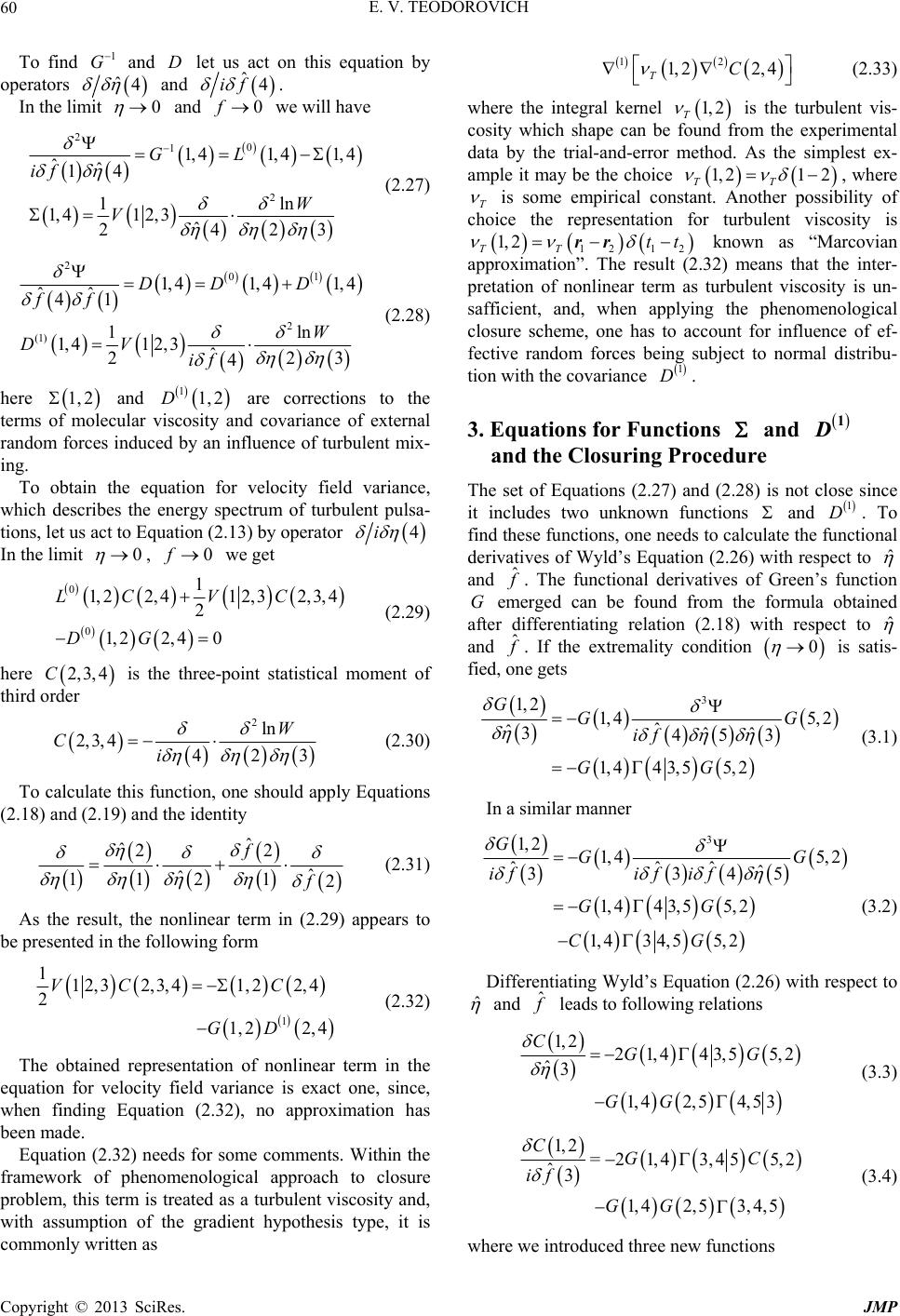 E. V. TEODOROVICH 60 To find and let us act on this equation by operators 1 GD ˆ4 and ˆ4if . In the limit 0 and we will have 0f 2 0 11, 4 ˆˆ 14 1,412, 3ˆ 24 GL if V 2 1, 41, 4 1ln 23 W (2.27) 2 (1) 1, 41, 4 ˆˆ 41 1 1, 412,3ˆ4 DD ff DV if 01 2 1, 4 ln 223 D W 11, 2D (2.28) here and are corrections to the terms of molecular viscosity and covariance of external random forces induced by an influence of turbulent mix- ing. 1, 2 To obtain the equation for velocity field variance, which describes the energy spectrum of turbulent pulsa- tions, let us act to Equation (2.13) by operator 4i 0 In the limit 0f, we get , 32, 3, 4C 2,3, 4C 0 0 1 1, 22, 412 2 1, 22, 40 LC V DG (2.29) here is the three-point statistical moment of third order 2ln 423 W 2,3,4Ci (2.30) To calculate this function, one should apply Equations (2.18) and (2.19) and the identity ˆ 22 ˆ 1 2f ˆ ˆ 11 2 f (2.31) As the result, the nonlinear term in (2.29) appears to be presented in the following form 112,32,3,4 2 1, VC 1 1, 22, 4 22,4 C GD 12 1, 22, 4 TC (2.32) The obtained representation of nonlinear term in the equation for velocity field variance is exact one, since, when finding Equation (2.32), no approximation has been made. Equation (2.32) needs for some comments. Within the framework of phenomenological approach to closure problem, this term is treated as a turbulent viscosity and, with assumption of the gradient hypothesis type, it is commonly written as 1, 2 1, 212 (2.33) where the integral kernel T is the turbulent vis- cosity which shape can be found from the experimental data by the trial-and-error method. As the simplest ex- ample it may be the choice TT , where T is some empirical constant. Another possibility of choice the representation for turbulent viscosity is 1, 2tt rr 1 D 12 12TT known as “Marcovian approximation”. The result (2.32) means that the inter- pretation of nonlinear term as turbulent viscosity is un- safficient, and, when applying the phenomenological closure scheme, one has to account for influence of ef- fective random forces being subject to normal distribu- tion with the covariance . 1 3. Equations for Functions and and the Closuring Procedure The set of Equations (2.27) and (2.28) is not close since it includes two unknown functions and . To find these functions, one needs to calculate the functional derivatives of Wyld’s Equation (2.26) with respect to 1 D ˆ and ˆ . The functional derivatives of Green’s function emerged can be found from the formula obtained after differentiating relation (2.18) with respect to G ˆ and ˆ . If the extremality condition 0 is satis- fied, one gets 3 1, 21,45, 2 ˆ ˆ3ˆˆ 453 1,443, 55,2 GGG if GG (3.1) In a similar manner 3 1, 21, 45, 2 ˆˆˆ ˆ 3345 1, 443,55,2 1, 434,55, 2 GGG ifif if GG CG ˆ (3.2) Differentiating Wyld’s Equation (2.26) with respect to ˆ leads to following relations and 1, 221,4 43,5 5,2 ˆ3 1,42, 54,53 CGG GG (3.3) 1, 2=21,43,4 55,2 ˆ3 1, 42,53, 4,5 CGC if GG (3.4) where we introduced three new functions Copyright © 2013 SciRes. JMP 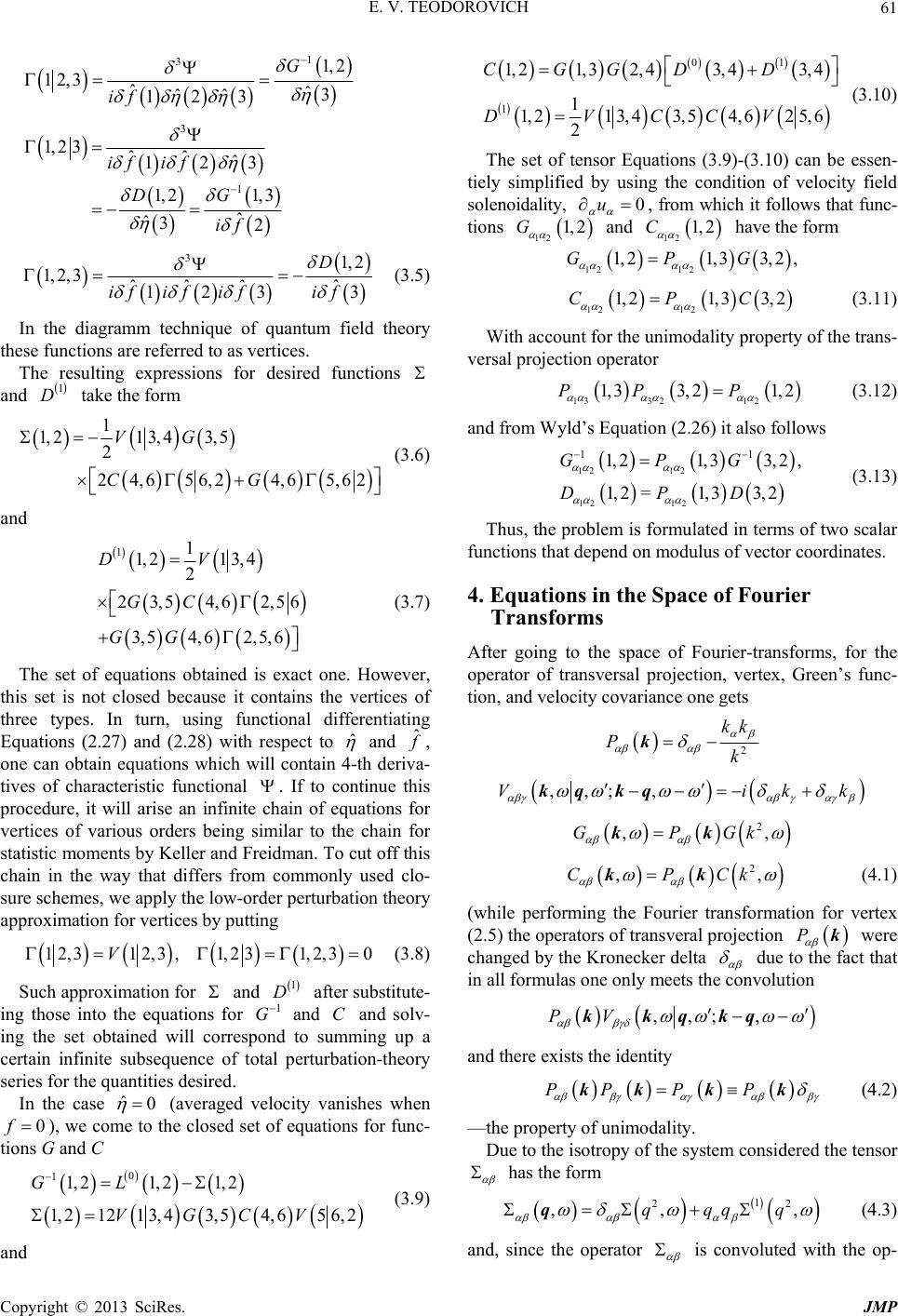 E. V. TEODOROVICH 61 11, 2 ˆ3 3 G 3 12 ,3 ˆˆˆ 12if 3 1, 23ˆˆ 1, 2 ˆ3 ifi 1 ˆ 12 3 1, 3 ˆ2 f DG if 31, 2 ˆ 3 3 D if 1, 2, 3ˆˆˆ 12if ifif (3.5) In the diagramm technique of quantum field theory these functions are referred to as vertices. The resulting expressions for desired functions and take the form 1 D 65,6 2 1 1, 21 3, 43, 5 2 24,65 6,24, VG CG (3.6) and 11 3, 4 ,62,5 6 2, 5,6 ˆ 11,22 2 3,54 3, 54, 6 DV GC GG (3.7) The set of equations obtained is exact one. However, this set is not closed because it contains the vertices of three types. In turn, using functional differentiating Equations (2.27) and (2.28) with respect to and ˆ , one can obtain equations which will contain 4-th deriva- tives of characteristic functional . If to continue this procedure, it will arise an infinite chain of equations for vertices of various orders being similar to the chain for statistic moments by Keller and Freidman. To cut off this chain in the way that differs from commonly used clo- sure schemes, we apply the low-order perturbation theory approximation for vertices by putting 1 2,31 2,3,1,23V 1,2,3 0 1 D 1 G ˆ0 (3.8) Such approximation for and after substitute- ing those into the equations for and C and solv- ing the set obtained will correspond to summing up a certain infinite subsequence of total perturbation-theory series for the quantities desired. In the case (averaged velocity vanishes when ), we come to the closed set of equations for func- tions G and C 0f 0 1 4,656,2CV 1, 21,21,2 1, 21213, 43,5 GL VG (3.9) and 01 1 1, 21,32,43, 43,4 1 1, 213,43, 54, 625, 6 2 CGGDD DVCCV 0u (3.10) The set of tensor Equations (3.9)-(3.10) can be essen- tiely simplified by using the condition of velocity field solenoidality, , from which it follows that func- tions 12 1,2G 12 1,2C and have the form 1212 1, 21,33, 2,GPG 1212 1, 21,33,2CPC (3.11) With account for the unimodality property of the trans- versal projection operator 13 3212 1, 33, 21,2PPP (3.12) and from Wyld’s Equation (2.26) it also follows 12 12 12 12 11 1, 21, 33, 2, 1, 2=1, 33, 2 GPG DPD (3.13) Thus, the problem is formulated in terms of two scalar functions that depend on modulus of vector coordinates. 4. Equations in the Space of Fourier Transforms After going to the space of Fourier-transforms, for the operator of transversal projection, vertex, Green’s func- tion, and velocity covariance one gets 2 kk Pk k ,,;,Vikk kq kq 2 ,,GPGk kk 2 ,,CPCk kk (4.1) (while performing the Fourier transformation for vertex (2.5) the operators of transveral projection P k were changed by the Kronecker delta due to the fact that in all formulas one only meets the convolution ,,;,PV kkqkq and there exists the identity PP PP kk kk (4.2) —the property of unimodality. Due to the isotropy of the system considered the tensor has the form 1 22 ,, ,qqqq q (4.3) and, since the operator is convoluted with the op- Copyright © 2013 SciRes. JMP 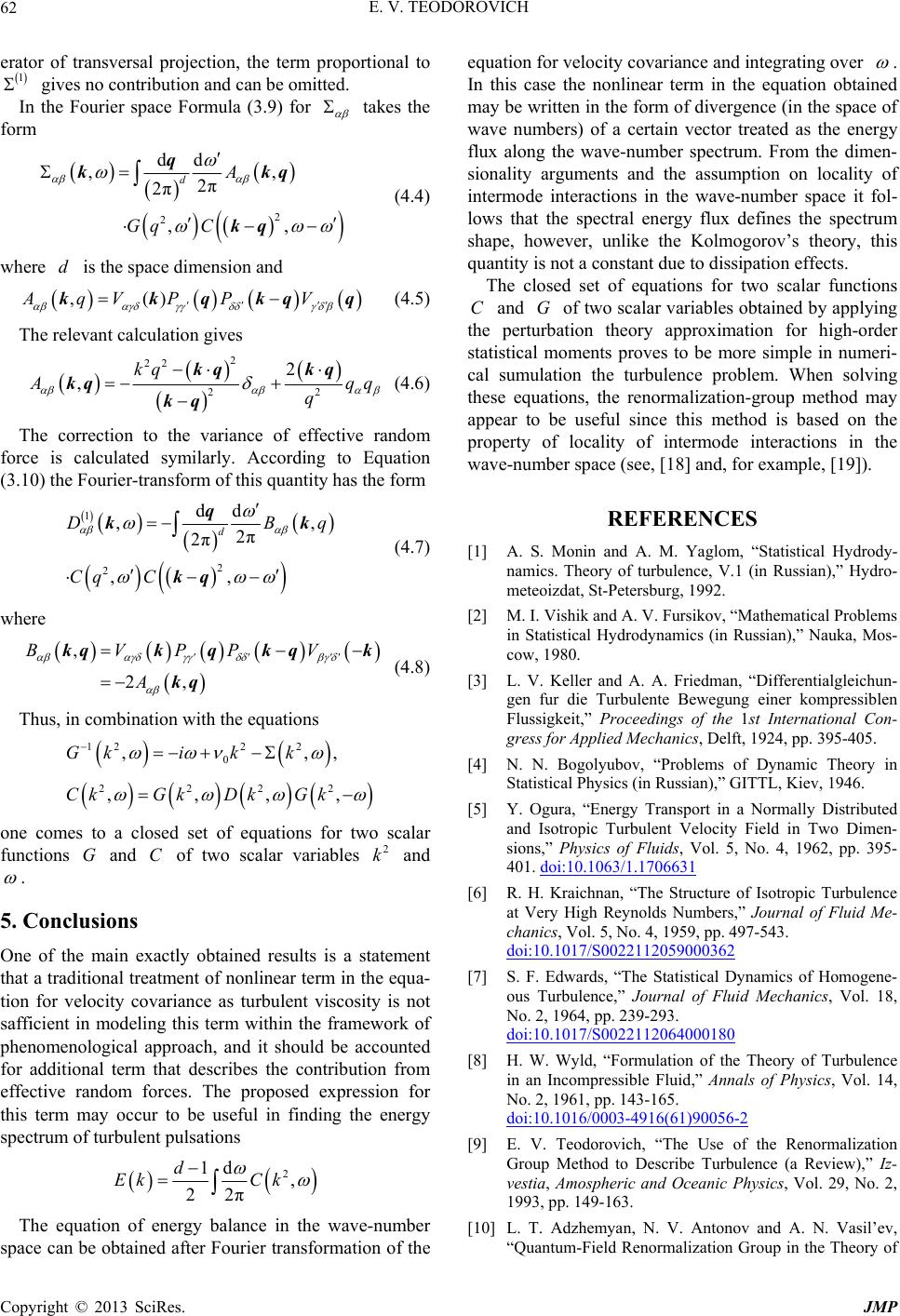 E. V. TEODOROVICH 62 erator of transversal projection, the term proportional to gives no contribution and can be omitted. 1 In the Fourier space Formula (3.9) for takes the form 2 ,, ,, 2 dd 2π 2πdA Gq C kk q kq d V kqq q (4.4) where is the space dimension and ,()AqVPP kkq (4.5) The relevant calculation gives 2 22 2 ,kq 2 2 qq q kq kq kq kq (4.6) The correction to the variance of effective random force is calculated symilarly. According to Equation (3.10) the Fourier-transform of this quantity has the form ,, 2π DBq kk V q k 1 2 2 dd 2π ,, d Cq C q kq (4.7) where , 2, BVPP A kqk qk kq (4.8) Thus, in combination with the equations 12 0 ,Gki2 2 ,,k k 22 ,,Gk 22 ,,CkGk Dk G C2 k one comes to a closed set of equations for two scalar functions and of two scalar variables and . 5. Conclusions One of the main exactly obtained results is a statement that a traditional treatment of nonlinear term in the equa- tion for velocity covariance as turbulent viscosity is not safficient in modeling this term within the framework of phenomenological approach, and it should be accounted for additional term that describes the contribution from effective random forces. The proposed expression for this term may occur to be useful in finding the energy spectrum of turbulent pulsations 2 1d , 22πCk d Ek The equation of energy balance in the wave-number space can be obtained after Fourier transformation of the equation for velocity covariance and integrating over . In this case the nonlinear term in the equation obtained may be written in the form of divergence (in the space of wave numbers) of a certain vector treated as the energy flux along the wave-number spectrum. From the dimen- sionality arguments and the assumption on locality of intermode interactions in the wave-number space it fol- lows that the spectral energy flux defines the spectrum shape, however, unlike the Kolmogorov’s theory, this quantity is not a constant due to dissipation effects. The closed set of equations for two scalar functions and G of two scalar variables obtained by applying the perturbation theory approximation for high-order statistical moments proves to be more simple in numeri- cal sumulation the turbulence problem. When solving these equations, the renormalization-group method may appear to be useful since this method is based on the property of locality of intermode interactions in the wave-number space (see, [18] and, for example, [19]). C REFERENCES [1] A. S. Monin and A. M. Yaglom, “Statistical Hydrody- namics. Theory of turbulence, V.1 (in Russian),” Hydro- meteoizdat, St-Petersburg, 1992. [2] M. I. Vishik and A. V. Fursikov, “Mathematical Problems in Statistical Hydrodynamics (in Russian),” Nauka, Mos- cow, 1980. [3] L. V. Keller and A. A. Friedman, “Differentialgleichun- gen fur die Turbulente Bewegung einer kompressiblen Flussigkeit,” Proceedings of the 1st International Con- gress for Applied Mechanics, Delft, 1924, pp. 395-405. [4] N. N. Bogolyubov, “Problems of Dynamic Theory in Statistical Physics (in Russian),” GITTL, Kiev, 1946. [5] Y. Ogura, “Energy Transport in a Normally Distributed and Isotropic Turbulent Velocity Field in Two Dimen- sions,” Physics of Fluids, Vol. 5, No. 4, 1962, pp. 395- 401. doi:10.1063/1.1706631 [6] R. H. Kraichnan, “The Structure of Isotropic Turbulence at Very High Reynolds Numbers,” Journal of Fluid Me- chanics, Vol. 5, No. 4, 1959, pp. 497-543. doi:10.1017/S0022112059000362 [7] S. F. Edwards, “The Statistical Dynamics of Homogene- ous Turbulence,” Journal of Fluid Mechanics, Vol. 18, No. 2, 1964, pp. 239-293. doi:10.1017/S0022112064000180 [8] H. W. Wyld, “Formulation of the Theory of Turbulence in an Incompressible Fluid,” Annals of Physics, Vol. 14, No. 2, 1961, pp. 143-165. doi:10.1016/0003-4916(61)90056-2 [9] E. V. Teodorovich, “The Use of the Renormalization Group Method to Describe Turbulence (a Review),” Iz- vestia, Amospheric and Oceanic Physics, Vol. 29, No. 2, 1993, pp. 149-163. [10] L. T. Adzhemyan, N. V. Antonov and A. N. Vasil’ev, “Quantum-Field Renormalization Group in the Theory of Copyright © 2013 SciRes. JMP  E. V. TEODOROVICH Copyright © 2013 SciRes. JMP 63 Hydrodynamic Turbulence,” Physics, Uspekhi, Vol. 39, No. 12, 1996, pp. 1193-1219. doi:10.1070/PU1996v039n12ABEH000183 [11] A. N. Kolmogorov, “Local Structure of Turbulence in Incompressible Fluid at Very Large Reynolds Numbers (in Russian),” Soviet Physics, Doklady, Vol. 39, No. 4, 1941, pp. 299-303. [12] B. B. Kadomtsev, “The Plasma Turbulence,” Academic Press, London, New York, 1965. [13] V. I. Belinicher and V. S. L’vov, “Scale-Invariant Theory of Developed Hydrodynamic Turbulence,” Journal of Experimental and Theoretical Physics (JETP), Vol. 66, No. 2, 1987, pp. 303-313. [14] E. V. Teodorovich, “Role of Local and Nonlocal Interac- tions in the Formation of the Developed Turbulence Re- gime,” Fluid Dynamics, Vol. 25, No. 4, 1990, pp. 522- 528. doi:10.1007/BF01049856 [15] R. M. Lewis and R. H. Kraichnan, “A Space-Time Func- tional Formalism for Turbulence,” Communication on Pure and Applied Mathematics, Vol. 15, No. 2, 1962, pp. 397-411. doi:10.1002/cpa.3160150403 [16] E. V. Teodorovich, “Application of the Methods from Quantum-Field Theory,” In the Monograph: A. S. Monin and A. M. Yaglom, Statistical Hydrodynamics. Theory of Turbulence. V.2, Sec. 29.4 (in Russian), St-Petersburg, Hydrometeoizdat, 1996. [17] E. V. Teodorovoch, “Diagram Equations of the Theory of Fully Developed Turbulence,” Theoretical and Mathe- matical Physics, Vol. 101, No. 1, 1994, pp. 1177-1183. [18] E. V. Teodorovich, “The Renormalization-Group Method in Problems of Mechanics,” Journal of Applied Mathe- matics and Mechanics (PMM), Vol. 68, No. 2, 2004, pp. 299-326. doi:10.1016/S0021-8928(04)90029-9 [19] E. V. Teodorovich, “Renormalization-Group Approach to Solving the Equation of Nonlinear Transfer,” Journal of Physics A: Mathematical and Theoretical, Vol. 42, No. 15, 2009, Article ID: 155202.
|